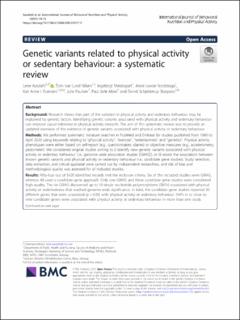| dc.contributor.author | Aasdahl, Lene | |
| dc.contributor.author | Nilsen, Tom Ivar Lund | |
| dc.contributor.author | Meisingset, Ingebrigt | |
| dc.contributor.author | Nordstoga, Anne Lovise | |
| dc.contributor.author | Evensen, Kari Anne Indredavik | |
| dc.contributor.author | Paulsen, Julie | |
| dc.contributor.author | Mork, Paul Jarle | |
| dc.contributor.author | Skarpsno, Eivind S. | |
| dc.date.accessioned | 2021-01-26T09:55:40Z | |
| dc.date.available | 2021-01-26T09:55:40Z | |
| dc.date.created | 2021-01-25T16:31:56Z | |
| dc.date.issued | 2021 | |
| dc.identifier.citation | International Journal of Behavioral Nutrition and Physical Activity. 2021, 18 (15), . | en_US |
| dc.identifier.issn | 1479-5868 | |
| dc.identifier.uri | https://hdl.handle.net/11250/2724730 | |
| dc.description.abstract | Background
Research shows that part of the variation in physical activity and sedentary behaviour may be explained by genetic factors. Identifying genetic variants associated with physical activity and sedentary behaviour can improve causal inference in physical activity research. The aim of this systematic review was to provide an updated overview of the evidence of genetic variants associated with physical activity or sedentary behaviour.
Methods
We performed systematic literature searches in PubMed and Embase for studies published from 1990 to April 2020 using keywords relating to “physical activity”, “exercise”, “sedentariness” and “genetics”. Physical activity phenotypes were either based on self-report (e.g., questionnaires, diaries) or objective measures (e.g., accelerometry, pedometer). We considered original studies aiming to i) identify new genetic variants associated with physical activity or sedentary behaviour (i.e., genome wide association studies [GWAS]), or ii) assess the association between known genetic variants and physical activity or sedentary behaviour (i.e., candidate gene studies). Study selection, data extraction, and critical appraisal were carried out by independent researchers, and risk of bias and methodological quality was assessed for all included studies.
Results
Fifty-four out of 5420 identified records met the inclusion criteria. Six of the included studies were GWAS, whereas 48 used a candidate gene approach. Only one GWAS and three candidate gene studies were considered high-quality. The six GWAS discovered up to 10 single nucleotide polymorphisms (SNPs) associated with physical activity or sedentariness that reached genome-wide significance. In total, the candidate gene studies reported 30 different genes that were associated (p < 0.05) with physical activity or sedentary behaviour. SNPs in or close to nine candidate genes were associated with physical activity or sedentary behaviour in more than one study.
Conclusion
GWAS have reported up to 10 loci associated with physical activity or sedentary behaviour. Candidate gene studies have pointed to some interesting genetic variants, but few have been replicated. Our review highlights the need for high-quality GWAS in large population-based samples, and with objectively assessed phenotypes, in order to establish robust genetic instruments for physical activity and sedentary behaviour. Furthermore, consistent replications in GWAS are needed to improve credibility of genetic variants. | en_US |
| dc.language.iso | eng | en_US |
| dc.publisher | BioMed Central | en_US |
| dc.rights | Navngivelse 4.0 Internasjonal | * |
| dc.rights.uri | http://creativecommons.org/licenses/by/4.0/deed.no | * |
| dc.title | Genetic variants related to physical activity or sedentary behaviour: a systematic review | en_US |
| dc.type | Peer reviewed | en_US |
| dc.type | Journal article | en_US |
| dc.description.version | publishedVersion | en_US |
| dc.source.volume | 18 | en_US |
| dc.source.journal | International Journal of Behavioral Nutrition and Physical Activity | en_US |
| dc.source.issue | 15 | en_US |
| dc.identifier.doi | https://doi.org/10.1186/s12966-020-01077-5 | |
| dc.identifier.cristin | 1878781 | |
| dc.description.localcode | This article is licensed under a Creative Commons Attribution 4.0 International License, which permits use, sharing, adaptation, distribution and reproduction in any medium or format, as long as you give appropriate credit to the original author(s) and the source, provide a link to the Creative Commons licence, and indicate if changes were made. The images or other third party material in this article are included in the article's Creative Commons licence, unless indicated otherwise in a credit line to the material. If material is not included in the article's Creative Commons licence and your intended use is not permitted by statutory regulation or exceeds the permitted use, you will need to obtain permission directly from the copyright holder. To view a copy of this licence, visit http://creativecommons.org/licenses/by/4.0/. The Creative Commons Public Domain Dedication waiver (http://creativecommons.org/publicdomain/zero/1.0/) applies to the data made available in this article, unless otherwise stated in a credit line to the data. | en_US |
| cristin.ispublished | true | |
| cristin.fulltext | original | |
| cristin.qualitycode | 2 | |

